The Big Pizza Spatula: A Comprehensive Guide
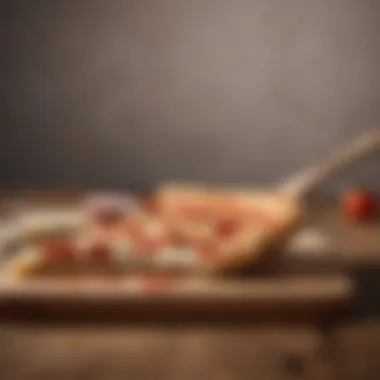
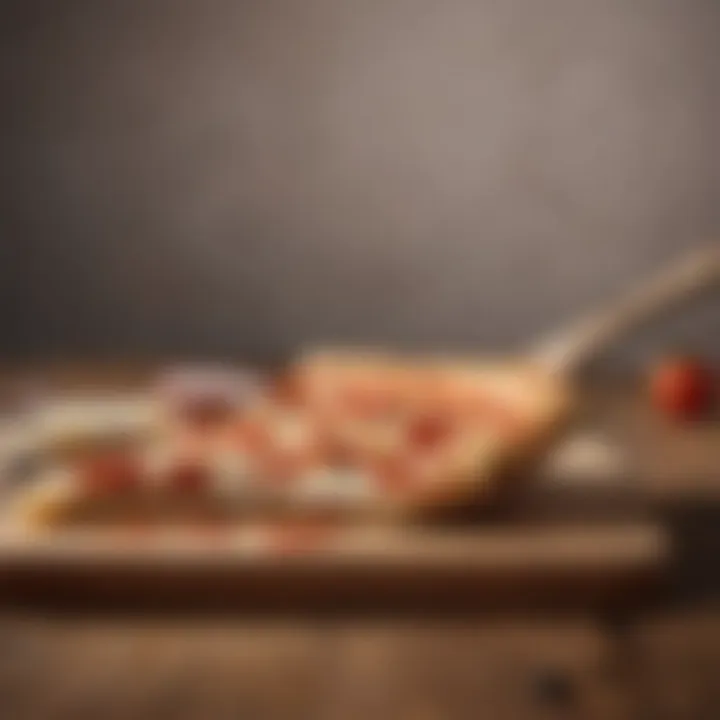
Intro
The big pizza spatula is an indispensable tool in the realm of pizza making. It serves multiple purposes, primarily facilitating the transfer of pizzas from baking surfaces to serving dishes. However, its significance goes beyond mere functionality; it reflects a blend of craftsmanship and culinary technique. By understanding the design, materials, and functionality of pizza spatulas, cooks can enhance their pizza experience, whether they are novices or seasoned chefs.
This guide aims to provide a comprehensive insight into the big pizza spatula. It will explore various designs, materials, and user preferences. Furthermore, we will delve into how to maintain this kitchen tool to ensure longevity. All aspects will contribute to a deeper appreciation and improved usage of the big pizza spatula, enriching the art of pizza making.
Key Points to be Discussed
- Types of Pizza Spatulas: Understanding the various models available and their specific uses.
- Materials Used: Analyzing the pros and cons of different materials in spatula construction.
- Cooking Techniques: How the spatula influences pizza baking and serving methods.
- User Preferences: Insights into how cooks choose their spatulas and why.
- Maintenance Practices: Tips for keeping the spatula in optimal condition for extended use.
- Perfect Pizza Delivery: Discussing the role of the spatula in achieving a flawless pizza experience.
"The right spatula is not just a tool; it is a partner in the creative journey of making the perfect pizza."
Prologue to the Big Pizza Spatula
The big pizza spatula is an essential utensil in both commercial and home kitchens. It serves several important functions that enhance the pizza-making process. Understanding its significance helps in appreciating why it has remained a staple tool for many years among culinary enthusiasts. The spatula enhances the way pizzas are handled, whether during preparation or serving. This introduction seeks to analyze its relevance, utility, and the unique features that make it indispensable in the kitchen.
Origins and Evolution
The history of pizza utensils is intertwined with the history of pizza itself. Initially, pizzas were baked directly on hot surfaces, often without any tools for handling them. As the popularity of pizza spread from Italy to the rest of the world, the need for specialized tools became apparent. The big pizza spatula emerged as a practical solution to address the challenges of moving hot pizzas in and out of the oven. Initially made from wood, its design has evolved significantly, now incorporating a variety of materials to improve your handling efficiency.
Today, numerous variations exist to cater to different cooking styles and preferences. This evolution reflects changes not only in culinary techniques but also in how pizza is appreciated across diverse cultures.
Purpose and Importance in the Kitchen
The primary purpose of the big pizza spatula is to facilitate the safe and effective handling of pizza. This spatula allows cooks to slide pizza into hot ovens and retrieve it once it’s done cooking. Its wide, flat surface provides ample support to large pizzas, preventing them from folding or tearing.
There are several key benefits associated with using this utensil:
- Improved Cooking Experience: By utilizing the big pizza spatula, cooks can focus on their recipe without worrying about damaging the pizza during transfer.
- Heat Resistance: Designed to withstand high temperatures, it enables chefs to work efficiently in intense cooking environments.
- Versatility: Beyond pizza, this spatula can be used for serving cake, bread, and other baked goods, making it a versatile tool in various culinary settings.
In summary, the big pizza spatula is more than just a tool; it's a critical component that elevates the entire pizza-making experience. Its development over time reflects not only changes in technology but also the growing importance of culinary practices aimed at enhancing cooking efficiency and safety.
Design Features of the Big Pizza Spatula
Understanding the design features of the big pizza spatula is essential for anyone looking to enhance their culinary skills. The design of the spatula influences its functionality, making it easier to handle and serve pizza effectively. There are two main aspects to focus on: blade shape and size, and handle design. Each element plays a crucial role in the performance of the spatula.
Blade Shape and Size
The blade of a pizza spatula is a critical component. Its shape and size directly affect how well it can support the weight of a pizza. Generally, wider blades are preferred, as they provide more surface area, making it easier to slide under a pizza. The optimal width may vary, but many professionals agree that a blade width of at least 12 inches is effective for standard pizzas.
Blade thickness is also important. A thin blade can easily slide under the pizza crust, allowing for a smooth lift without causing any damage. Conversely, a thicker blade can add strength but may become cumbersome when maneuvering.
Each blade shape serves different purposes. For instance:
- Rectangular blades are common. They offer good support for traditional round pizzas.
- Round blades often cater to the needs of Neapolitan pizzas, which are shaped larger and need specific handling.
Ultimately, the choice depends on what type of pizza you prepare.
Handle Design
The handle of a pizza spatula should provide comfort and control. Comfort is especially vital when handling larger pizzas, which can require significant strength. A well-designed handle allows for secure gripping, reducing the chances of slips. Most handles are either made of wood or durable plastic, each offering different tactile experiences.
Length is another factor in handle design. A longer handle can keep your hands away from high heat, which is beneficial when retrieving pizzas from an oven. Shorter handles may provide better maneuverability, but they put your hands closer to the heat source. Consider your cooking environment when choosing.
In addition to comfort and length, handle shape also matters. Ergonomic designs, which fit the contours of the hand, can make a significant difference in ease of use. Flat handles may look good but can lead to discomfort during extended use. A good handle combines comfort, safety, and accessibility for the best performance.
Choosing the right pizza spatula involves understanding design features, comfort, and the specific needs of your cooking style.
All these design elements come together to create a versatile tool that enhances the pizza making process, making it not just easier, but more enjoyable too.
Materials Used in Pizza Spatula Manufacturing
The material used in pizza spatula production holds significant weight in both functionality and user experience. Subtle variations in material can yield a range of performance characteristics, impacting ease of use and durability. Therefore, understanding these materials is essential for anyone looking to invest in a pizza spatula that meets their cooking needs.
Wood versus Metal
Wood and metal are the primary materials used for crafting pizza spatulas. Each material has its own set of advantages and drawbacks.
Wood Spatulas
Benefits:
- Gentle on Surfaces: Wood spatulas tend to be softer, limiting the risk of scratching your pizza stone or oven surfaces.
- Natural Insulator: Wood does not conduct heat the same way metal does, allowing for safer handling during high-temperature cooking.
- Lightweight: Wooden spatulas are often lighter, making them easier to maneuver.
Drawbacks:
- Maintenance: Wood requires regular oiling and careful washing to prevent damage, such as warping or cracking.
- Durability: Over time, wood can show signs of wear and is susceptible to moisture absorption, which can lead to bacterial growth if not cleaned properly.
Metal Spatulas
Benefits:
- Durable: Metal spatulas are robust and can withstand higher temperatures and heavy use.
- Easy to Clean: Most metal spatulas are dishwasher-safe and do not retain odors or stains.
- Versatile Designs: The rigidity of metal allows for various shapes and sizes, including perforated designs that enable better grease or moisture drainage.

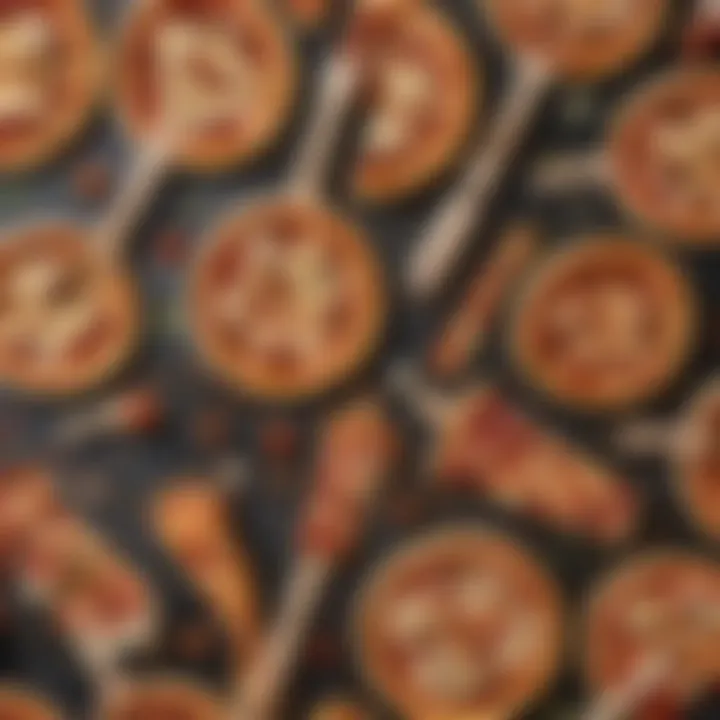
Drawbacks:
- Heat Conductivity: Metal can become hot quickly, posing a risk of burns during usage.
- Surface Scratches: Depending on the finish, metal spatulas can scratch surfaces more easily when used carelessly.
Impact of Different Materials on Performance
When it comes to pizza cooking, the choice of material directly affects the spatula's performance. Here are key points to keep in mind:
- Heat Tolerance: Metal spatulas generally have a higher heat tolerance compared to their wooden counterparts. They can function effectively in high-temperature ovens without risk of damage.
- Flexibility: The flexibility of a spatula impacts its handling. A wooden spatula, while generally more flexible, may not always provide the same leverage as a rigid metal one.
- Grip: A textured or rubberized handle can enhance grip during use. Materials like silicone are also becoming popular since they provide a heat-resistant grip with a soft touch.
In summary, the choice of material for a pizza spatula will have lasting implications on its performance and overall user experience. It’s crucial to weigh the benefits and drawbacks carefully before making a decision.
Different Types of Big Pizza Spatulas
Understanding the various types of big pizza spatulas is crucial for anyone who enjoys making pizza, whether at home or in a professional setting. Each type serves distinct purposes and is designed considering specific functionalities, which can significantly impact the pizza preparation and serving experience. Selecting the right spatula can affect not just efficiency but also the quality of the final dish. Here, we explore the key categories that define the world of pizza spatulas.
Standard Pizza Spatulas
Standard pizza spatulas are the most commonly used tools for pizza enthusiasts. They typically feature a broad blade that allows for easy loading and unloading of pizzas into and out of hot ovens. These spatulas vary in size, usually ranging from 12 inches to 16 inches, depending on the personal needs and preferences of the user. The design prioritizes stability, enhancing the user's grip and control while maneuvering the pizza.
When choosing a standard pizza spatula, consider the following factors:
- Blade Material: Stainless steel is often preferred for its durability and ease of cleaning. Some may choose wood for its aesthetic appeal and traditional touch.
- Handle Length: A longer handle can keep your hands safe from heat while allowing for the necessary leverage.
- Weight: A well-balanced spatula is essential for effortless handling without feeling cumbersome.
Perforated Versus Solid Spatulas
The debate between perforated and solid spatulas is common among pizza makers. Both serve a purpose, but the end goals differ. Perforated spatulas have small holes in the blade, allowing for excess flour or oil to fall away, which can be advantageous when transferring pizzas. This can result in a crispier crust since moisture is less likely to be trapped.
Contrastingly, solid spatulas provide a larger surface area for stability, making them ideal for handling larger pizzas. Here are some considerations:
- Perforated Spatulas: Useful for removing pizzas from a stone oven, minimizing the weight during transfer. They also offer better airflow for cooking.
- Solid Spatulas: Great for flipping and serving, suiting those who prefer to maintain all ingredients on the pizza until it reaches the plate.
Custom and Specialty Spatulas
For the serious pizza aficionado, custom and specialty spatulas offer unique advantages. These spatulas are made to cater to specific pizza styles or personal preferences. A custom spatula might have a unique blade size or handle shape that fits a user's style.
Specialty spatulas are designed for niche uses, such as deep-dish pizzas or oversized pizzas. Using these designed tools can enhance the overall experience while allowing cooks to experiment with various pizza styles. Look for:
- Tailored Designs: Custom options might include engraving or specific shapes suited for certain cooking techniques.
- Material Variety: Does the spatula use silicone or another alternative that accommodates non-stick pan users?
"The right spatula can make or break your pizza experience."
Choosing wisely can lead to more successful outcomes in your kitchen.
Using the Big Pizza Spatula Effectively
Using the big pizza spatula is not just about convenience; it is an essential part of the pizza-making process. Its proper application can significantly influence the quality of the final product. For both home cooks and professionals, understanding how to use this tool effectively maximizes efficiency in the kitchen and elevates the overall pizza experience. Key elements involve loading and unloading from the oven and mastering serving techniques.
Loading and Unloading the Oven
When it comes to loading the pizza into the oven, the spatula acts as a bridge between countertop and oven. A large spatula allows you to slide pizzas in without losing shape or toppings. Here are steps to do it right:
- Preheat the Oven: Start with a thoroughly preheated oven. A hot oven ensures that the crust cooks evenly and becomes crispy.
- Use Cornmeal or Flour: Lightly dust the spatula’s surface with cornmeal or flour. This prevents sticking and allows for smooth transfers.
- Get Low: Position the spatula low and angle it slightly. Slide it under the pizza without lifting it excessively, which reduces the chances of the pizza losing structural integrity.
- Quick Movements: Once positioned, glide the pizza into the oven swiftly. Delays may cause moisture to condense on the pizza, affecting texture.
Unloading is equally critical. Use these tips:
- Check for Doneness: Before removing, ensure the pizza has a golden crust and melted cheese.
- Tilt for Safety: Slightly tilt the spatula as you withdraw the pizza. This technique decreases the risk of tipping or dropping the pizza.
- Place on a Cooling Rack: Let the pizza rest on a cooling rack to maintain its texture and prevent sogginess.
"Mastering loading and unloading techniques can determine the success of your pizza night."
Serving Techniques
Serving pizza involves more than just cutting it and placing it on a plate. The right techniques enhance presentation and ensure a delightful experience. Consider the following aspects:
- Use of a Sharp Knife: Invest in a quality pizza cutter or knife. Clean cuts maintain the toppings’ arrangement and avoid mess.
- Positioning: When serving, position the spatula underneath a slice from the edge rather than the center. This technique prevents toppings from sliding off.
- Serve Hot: Serve each slice quickly after cutting to ensure the cheese remains gooey and appealing.
To enhance the service, consider some additional practices:
- Garnishing: Add fresh herbs or spices just before serving for a burst of flavor.
- Pairing: Suggest complementary dips or siders like marinara or garlic butter. This adds an interactive element to the dining experience.
By effectively using the big pizza spatula, one can not only make the pizza-making process easier but also improve the dining experience for everyone involved.
Maintenance and Care Tips
Maintaining a big pizza spatula is essential for ensuring its longevity and efficiency. This section outlines the key aspects of proper care, focusing on cleaning and storage practices. A well-maintained spatula not only performs better but also contributes to the overall quality of the pizza experience.
Cleaning Procedures
Cleaning your pizza spatula should happen after each use. The materials of the spatula can significantly influence the cleaning approach. For wooden spatulas, it's best to avoid submerging them in water. Instead, use a damp cloth to wipe off any food residue. After wiping, let it air dry to prevent warping or cracking.
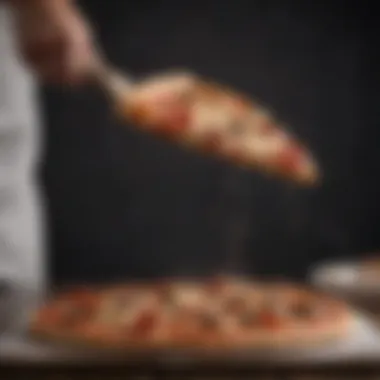
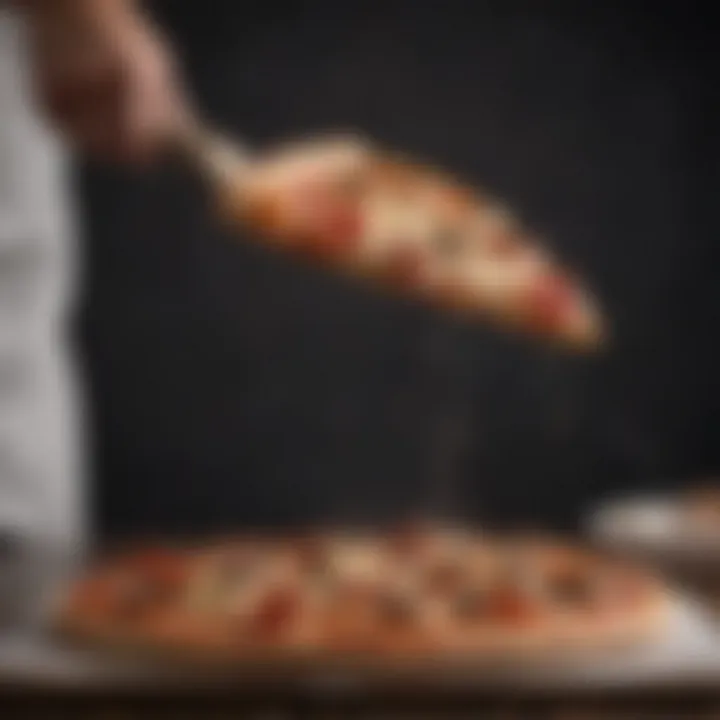
For metal spatulas, however, you can safely rinse them under warm water. Use a mild dish soap to remove any greasy residues. It is crucial to dry them promptly with a towel, as leaving them wet can lead to rusting over time.
Proper cleaning helps maintain flavor integrity and prevents cross-contamination.
Storage Recommendations
Storing your big pizza spatula correctly is equally as important as cleaning it. When not in use, wooden spatulas should be stored in a manner that keeps them dry and away from direct sunlight. A drawer or a hanging rack is ideal. This prevents warping and ensures the wood remains in good shape.
Metal spatulas, on the other hand, can be stored in a kitchen utensil holder or a drawer, but they should be separated from other metallic tools to avoid scratches. It’s beneficial to store them in a way that does not bend or warp their shape.
In summary, proper maintenance of your pizza spatula involves both regular cleaning routines and careful storage practices. This not only prolongs the life of the spatula but also enhances your pizza-making experience.
Comparative Analysis of Popular Brands
In the world of pizza spatulas, brand selection is crucial. The right spatula can elevate not only the efficiency of cooking but also enhance the overall pizza experience. Evaluating various brands is essential for home chefs and professionals alike. This analysis will examine each brand's unique features, durability, and customer satisfaction. By comparing well-known brands, potential buyers can make informed decisions that best suit their cooking styles and needs.
Brand A Overview
Brand A is a prominent player in the pizza spatula market. It is recognized for its extensive product range, catering to both amateur and professional cooks. The major strength of Brand A lies in its commitment to quality. The materials used, such as stainless steel for the blade and ergonomic wood for the handle, are selected carefully. This blend results in durability and comfort during use.
Users frequently praise Brand A for its lightweight designs, which enable easier handling, especially when maneuvering pizzas in and out of ovens. Additionally, many find the spatula's wide blade effective in supporting large pizzas without bending. User feedback often highlights positive experiences regarding the durability of the spatula after frequent use. However, some may note that the price point is slightly higher than lesser-known brands, indicating a trade-off between cost and quality.
Brand B Overview
Brand B offers a different approach in the pizza spatula arena. This brand is often associated with affordability without sacrificing key features. Its spatulas typically feature a solid metal construction, appealing to those who prioritize sturdiness over weight. Users frequently mention the robust nature of Brand B's products, noting that it can withstand tougher usage in professional settings.
One unique point about Brand B is its customizable options. Customers can choose their preferred colors and finishes. This personalization aspect resonates well with buyers looking for unique kitchen tools. However, there are some concerns regarding the handle's comfort. Some reviews suggest that it could be more ergonomic. Overall, Brand B provides strong competition in the marketplace, capturing the attention of budget-conscious cooks who still desire functionality and reliability.
User Reviews and Preferences
Feedback from consumers about big pizza spatulas plays an essential role in understanding their functionality and user experience. Reviews not only provide insight into the performance of various brands but also highlight the features that truly matter to both novice and expert cooks. By analyzing user experiences, potential buyers can make informed decisions. This focus on real-world use can elevate the overall cooking experience, allowing individuals to select spatulas that meet their specific needs, preferences, and cooking styles.
Common Complaints
Even though many spatulas are designed to serve pizza effectively, users often voice certain complaints that can help manufacturers improve their products. Some common issues include:
- Weight: Many users find that heavier spatulas can be cumbersome, especially for prolonged use. A spatula that is too heavy can cause fatigue during serving.
- Flexibility: A spatula lacking sufficient sturdiness can lead to difficulties in lifting pizzas without them bending or breaking, impacting the overall experience.
- Handle Comfort: Several consumers report discomfort in their hands due to poorly designed handles. An ergonomically designed handle is crucial for ease of use.
- Durability: Some users find that cheaper models tend to wear out or warp after a few uses. This often frustrates customers who expect their spatula to stay in good condition longer.
Addressing these complaints can lead manufacturers to innovate and develop more user-friendly products.
Features Cited as Essential
When it comes to picking a spatula, certain features repeatedly emerge as fundamental in user reviews. Notable mentions include:
- Material Quality: Users prefer spatulas made from high-quality materials, such as stainless steel or hardwood, that ensure durability and effective pizza handling.
- Blade Size: Many users appreciate a larger blade area for accommodating a variety of pizza sizes. A larger blade facilitates easy lifting and serving.
- Ergonomic Design: A handle that is comfortable to grip and use for extended periods is often cited as a top priority.
- Weight Balance: Proper weight distribution makes a spatula easy to handle and ensures better control while serving.
Conclusively, insights gained from user reviews illuminate the pivotal aspects of pizza spatula design and functionality. Future products can benefit from these perspectives, enhancing the cooking and serving experience for many.
The Role of Pizza Spatulas in Professional Kitchens
In professional kitchens, especially those that specialize in pizza, the pizza spatula plays a crucial role. Its design and function are specifically tailored for handling pizzas of various sizes and shapes. The efficiency and speed of service depend on the ease of use and reliability of the spatula. Without it, achieving the right presentation of a pizza from the oven to the serving area becomes a daunting task.
A well-designed pizza spatula enhances the cooking process. It allows chefs to safely maneuver hot pizzas, minimizing the risk of burns or accidents. This tool is not just a convenience; it is a necessity that impacts the overall workflow of the kitchen.
Training New Staff
Training new staff in using the pizza spatula is a vital part of kitchen operations. Chefs need to ensure that every team member understands how to handle this tool correctly. This instruction goes beyond simply holding the spatula; it involves precise techniques for loading and unloading pizzas from the oven.
Here are some critical points in training new staff:
- Grip Technique: Ensure trainees learn to grip the handle firmly without excessive pressure. This grip aids in lifting and positioning pizzas easily.
- Angle Awareness: Train staff to be aware of how to angle the spatula when sliding under a pizza. This minimizes the risk of pizza toppings sliding off.
- Timing and Speed: Encourage practice in timing when to lift the pizza from the oven. Quick and efficient movements are essential during busy service hours.
Proper training not only increases safety but also helps in maintaining the quality of the pizza during service.
Standard Practices in Pizzerias
Standard practices for using pizza spatulas in pizzerias are developed through years of experience. These practices ensure efficiency and consistency in serving pizzas. Here are some crucial aspects:
- Use of Perforated Spatulas: Many pizzerias prefer perforated spatulas. The holes allow excess flour or moisture to fall away, keeping the crust intact and preventing sogginess.
- Consistent Size Selection: Pizzerias typically keep spatulas of different sizes on hand. This variety accommodates the different dimensions of pizzas being made.
- Regular Maintenance Checks: Frequent checks on the performance of the spatulas are essential. Damage or wear can lead to ineffective use, which affects the quality of service.
In summary, the pizza spatula is not merely a tool; it is integral to the operations of a pizzeria. Training staff and adhering to standard practices ensures that pizzas are well-handled and presented to customers.
"An efficient kitchen is one where every tool serves its purpose seamlessly, and the pizza spatula is at the heart of every great pizza experience."
Innovations in Pizza Spatula Design
Innovations in pizza spatula design play a critical role in enhancing both the functionality and efficiency of this essential kitchen tool. As cooking techniques evolve and the culinary landscape becomes more diverse, the demand for spatulas that meet the needs of both professional chefs and home cooks has increased. Recent developments have shifted focus on materials, ergonomics, and versatility, resulting in spatulas that are not only effective but also enjoyable to use.
Technological Advancements
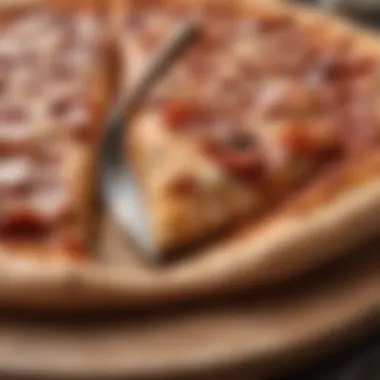

Technological advancements in the design of pizza spatulas have led to several key improvements. For instance, the use of high-temperature resistant materials allows spatulas to withstand the rigors of a commercial kitchen while maintaining their structural integrity. Some spatulas now incorporate non-stick coatings, which help in preventing food from adhering to the surface, making them easier to use and clean.
Moreover, innovations such as heat sensors have been integrated into some models. These sensors can indicate when food has reached the optimal cooking temperature, ensuring a perfect bake every time. Such features are particularly beneficial in busy kitchens, where precision and speed are priorities.
Additionally, many spatulas now come with enhanced blade designs that improve airflow. This design not only reduces drag while lifting pizza but also minimizes the chances of toppings sliding off, ensuring the perfect slice every time.
Collaborations with Culinary Experts
Collaborations with culinary experts have also shaped the design of modern pizza spatulas. Renowned chefs and culinary institutions often test prototypes and provide feedback on ergonomics, aesthetics, and functionality. Their insights contribute to creating spatulas that are not only practical but also infused with professional-grade quality.
The partnership between manufacturers and culinary educators often focuses on promoting good practices in pizza making. For instance, spatulas designed with comfortable grips are particularly refined, allowing chefs to work for extended periods without discomfort. Involving experts helps to ensure that these tools meet real-life cooking challenges, offering users a reliable experience.
Furthermore, these collaborations frequently address sustainability issues. Many manufacturers are now exploring eco-friendly materials and production methods, aligning with the growing trend towards sustainable cooking practices. The adoption of recycled or responsibly sourced materials in spatula design becomes a selling point for conscientious consumers.
Ultimately, the innovations in pizza spatula design reflect a broader trend in culinary tools: the integration of technology, collaboration with experts, and a focus on sustainability. By embracing these changes, both chefs and home cooks can benefit from a more efficient and enjoyable cooking experience.
Embracing innovation in kitchen tools leads to culinary excellence, transforming everyday cooking into an extraordinary experience.
Considerations for Home Cooks
When it comes to using a big pizza spatula, home cooks should pay attention to several key elements. The right spatula can significantly enhance the process of preparing and serving pizza. This section explores important considerations that every home cook should make when selecting and using their spatula.
Choosing the Right Spatula
Selecting the ideal spatula is crucial. The size and shape matter. A larger blade can accommodate bigger pizzas, while a slightly angled blade aids with maneuverability. A flatter spatula is better for sliding under the pizza, while a slightly rounded edge may help in lifting the pizza quickly.
Several factors should influence your choice:
- Blade Material: Stainless steel and aluminum are durable choices. Each offers different heat conductivity.
- Handle Comfort: A sturdy, heat-resistant handle is essential. Look for materials that ensure a firm grip without slipping.
- Weight: Consider how heavy it feels in your hand. A lighter spatula may be easier to control, especially for longer usage periods.
In summary, your spatula should feel balanced and comfortable. If possible, hold it in the store before purchasing.
Recommended Practices for Optimal Use
To use the big pizza spatula effectively, home cooks should follow specific practices that enhance both safety and efficiency. Effective usage not only protects the pizza but also simplifies the experience of cooking and serving.
Here's a breakdown of recommended practices:
- Preheat the Spatula: When putting pizza into a hot oven, preheating the spatula can prevent sticking.
- Use a Rocking Motion: When lifting or sliding the pizza, gently rock the spatula. This helps to unstick the dough from the pizza stone or baking sheet.
- Establish a Technique: Practice loading and unloading pizzas in a fluid motion to minimize spills. Consistent practice builds confidence and speed in your technique.
- Clean Immediately: To maintain the spatula’s performance, clean it right after use. This prevents residue from hardening and ensures a hygienic cooking tool.
By actively incorporating these practices, home cooks can ensure they maximize the capabilities of their spatulas while achieving an exceptional pizza experience.
Culinary Trends Influencing Pizza Tools
Culinary trends shape the tools and techniques that chefs and home cooks employ in their kitchens. For pizza enthusiasts, understanding these trends can enhance the overall experience from preparation to presentation. The big pizza spatula is no exception, as it adapts to reflect preferences that extend beyond functionality to include sustainability and aesthetics.
Sustainability in Kitchen Tools
Sustainability has become a pivotal concern in modern cooking. The food industry increasingly seeks ways to reduce environmental impact. When it comes to pizza spatulas, several considerations emerge. Firstly, the materials used in their production play a significant role. Spatulas made from sustainably sourced wood or recycled metals are gaining popularity. This shift not only minimizes waste but also appeals to environmentally conscious consumers.
Moreover, accepting biodegradable utensils is a growing trend. Many manufacturers have started offering spatulas constructed from compostable materials. These choices reflect a broader commitment to sustainability within the culinary framework.
Sustainability does not only end with materials. It also involves packaging and the production process. Companies that prioritize eco-friendly methods often earn loyalty from modern consumers. Here are key points regarding sustainable pizza spatulas:
- Use of sustainably sourced wood or recycled materials
- Biodegradable options available
- Eco-friendly packaging practices
- Production methods that minimize waste
"Sustainable kitchen tools not only benefit the planet but also enhance the quality of your cooking experience."
Overall, selecting a sustainable pizza spatula can lead to a more ethical approach to cooking, aligning personal values with culinary practices.
Aesthetic Trends in Kitchenware
Shifts in consumer preferences about aesthetics are also influencing the types of pizza spatulas that are popular today. The kitchen is often seen as a reflection of personal style. Therefore, items like spatulas must go beyond their functional aspects and into the realm of design. The trend now is to have tools that are not only effective but also visually appealing.
Many people are opting for spatulas that incorporate vibrant colors, unique shapes, and stylish finishes. These features elevate the spatula from a mere tool to a key player in kitchen decor. Additionally, the rise of social media has encouraged people to share their culinary creations, prompting an interest in how tools like pizza spatulas are perceived.
Key elements influencing aesthetic trends in pizza spatulas include:
- Varied color options that complement kitchen themes
- Design elements that showcase craftsmanship and artistry
- Use of trendy finishes such as brushed metals or matte surfaces
In a kitchen where aesthetics meet functionality, stylish spatulas become conversation starters and inspirations for culinary creativity. This dual focus on design and utility is essential for today’s food lovers who wish to impress.
By marrying sustainability with aesthetic appeal, the pizza spatula has evolved to meet the demands of an increasingly discerning clientele, ensuring its place in both home and professional kitchens.
The End
The conclusion provides a necessary closure to the exploration of the big pizza spatula. It emphasizes the integral role this tool plays in achieving culinary success with pizza. Beyond its practical use, the spatula is a symbol of craftsmanship in the kitchen, where it unites the elements of skill and art.
Summary of Key Insights
Throughout this article, key insights have emerged regarding the big pizza spatula. First, the design features, including blade shape and handle design, significantly affect usability. The materials used in manufacturing—such as wood and metal—impact performance, offering various benefits depending on cooking methods. Additionally, user experiences highlight the importance of features like grip and weight, which can influence preferences in different cooking environments. Furthermore, innovations in design reflect broader culinary trends, pointing toward sustainability and aesthetics that engage modern cooks.
Future Outlook for Pizza Spatulas
Looking ahead, the future of pizza spatulas seems promising. As culinary trends evolve, so will the tools in our kitchens. We can expect more emphasis on sustainable materials, thus enhancing the eco-friendliness of products like the pizza spatula. Moreover, with the rise of gourmet cooking at home, there may be an increase in demand for specialty spatulas that cater to diverse cooking styles. Innovations, possibly integrating smart technology for enhanced cooking accuracy, could emerge as well. The journey of the pizza spatula is ongoing, and its role in the kitchen will likely continue to adapt to meet the needs of both amateur cooks and seasoned chefs.







